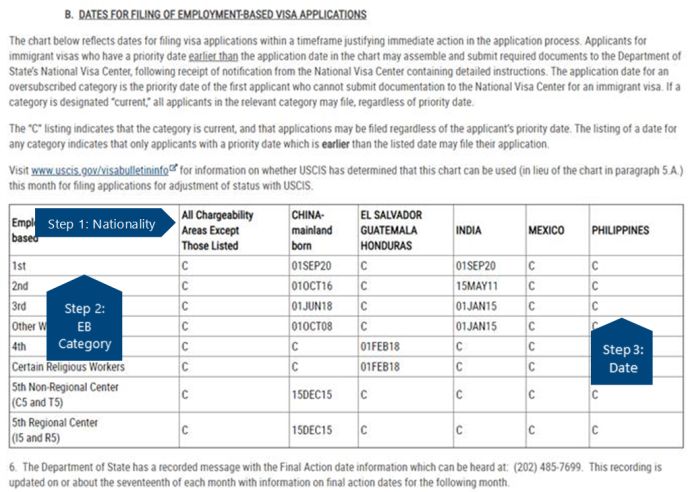- within Law Practice Management, Wealth Management and Insurance topic(s)
COVID-19 developments, including the White House ban on green card applications made at US consulates abroad, economic changes, and reduced cross-border travel, reduced the volume of applications for immigrant visas in recent months, creating excess supply in employment-based (EB) immigrant quotas.
As a result, the US Department of State (DOS) adjusted the EB quotas to allow certain individuals who previously faced lengthy waits of up to multiple years to file for adjustment of status (AOS) to US permanent residency in the month of October 2020.
The spouse and minor children (under 21 and unmarried) of eligible EB candidates may also file for AOS.
Along with the AOS filings on Form I-485, the partners, their spouses, and children eligible to work may apply for AOS-based work permits (EADs) on Forms I-765, and they may all apply for travel permits (advance paroles) on Forms I-131.
To qualify, individuals must be in the United States lawfully, continue to be supported by their sponsoring employer, and have an EB "priority date" that is within the newly announced quota cut-off dates.
Eligible Priority Dates
Candidates with "priority dates" that are no later than the dates on the DOS October 2020 Visa Bulletin for their EB categories may apply for adjustment of status in October 2020.
The cut-off dates include an EB reference:
- EB-1 applies to foreign nationals of extraordinary ability (EB-1A), outstanding researchers (EB-1B), or multinational executives or managers (EB-1C)
- EB-2 applies to foreign nationals with advanced degrees (master's or higher), or individuals whose work is considered to be in the national interest
- EB-3 applies to, among others, foreign nationals with bachelor's degrees or, for those without degrees skilled workers with two years of training
The cut-off dates include a nationality reference:
- Candidates from 5 regions – (1) China, (2) El Salvador, Guatemala, Honduras, (3) India, (4) Mexico, and (5) Philippines have unique EB cut-off dates
- Nationals of any other country are subject to the "all chargeability areas" reference
The priority date for each candidate is as follows:
- For EB-1 candidates the date of USCIS receipt of the employer's I-140 petition,
- For most EB-2 and all EB-3 candidates whose cases included a PERM filing (Form ETA 9089) with the Department of Labor (DOL), the date of the DOL's receipt of the PERM
- In both cases, the priority date is listed on the I-797 receipt of the employer's immigrant sponsorship petition (Form I-140), and the PERM-based candidates also will have the dates listed on their PERM receipts
Evaluating Priority Date for a Candidate

Special Circumstances
Priority date is timely but:
- Employer has prepared and/or filed PERM, but PERM is not yet
certified, and EB quota for candidate is current
- Premature to file AOS. If the only category for the candidate is PERM-based, the PERM certification is required before the employer's immigrant sponsorship petition (Form I-140) and AOS (Form I-485) can be filed
- Employer has PERM approval, but has not yet filed Form I-140,
and EB quota for candidate is current
- Ripe to file AOS. Form I-140 can be filed jointly with the AOS Form I-485
- Candidate is a senior executive working in the US as an L-1A
nonimmigrant, but employer has not started any permanent residency
process, and EB quota for candidate is current
- Option to consider filing AOS. If the executive worked in a managerial or executive position overseas for at least one of the three years preceding transfer to the US, the employer may consider filing an EB-1C multinational executive or manager petition, with Form I-140 filed jointly with the AOS Form I-485
- Candidate is working in the US as an O-1 nonimmigrant, but
employer has not started any permanent residency process, and EB
quota for candidate is current
- Option to consider filing AOS. The employer may consider filing an EB-1A petition documenting the distinguished record of the candidate, with Form I-140 filed jointly with the AOS Form I-485
- EB-2 quota for candidate's nationality is not ripe, but
EB-3 is, and PERM approval supports either classification
- Option to consider. Employer may wish to file a petition to classify the candidate as EB-3, subject to input from counsel as to whether reclassification into EB-3 is viable
Because the volume of filings as of October 2020 is expected to rise dramatically in response to the open window, there is a risk that the EB quota filing window will close for candidates who now have an opportunity to file the AOS.
Mayer Brown has developed an AOS Action Plan to assist employers with filings for AOS (and the related I-140 filings if needed) for October 2020, which we would be pleased to discuss.
Visit us at mayerbrown.com
Mayer Brown is a global legal services provider comprising legal practices that are separate entities (the "Mayer Brown Practices"). The Mayer Brown Practices are: Mayer Brown LLP and Mayer Brown Europe - Brussels LLP, both limited liability partnerships established in Illinois USA; Mayer Brown International LLP, a limited liability partnership incorporated in England and Wales (authorized and regulated by the Solicitors Regulation Authority and registered in England and Wales number OC 303359); Mayer Brown, a SELAS established in France; Mayer Brown JSM, a Hong Kong partnership and its associated entities in Asia; and Tauil & Chequer Advogados, a Brazilian law partnership with which Mayer Brown is associated. "Mayer Brown" and the Mayer Brown logo are the trademarks of the Mayer Brown Practices in their respective jurisdictions.
© Copyright 2020. The Mayer Brown Practices. All rights reserved.
This Mayer Brown article provides information and comments on legal issues and developments of interest. The foregoing is not a comprehensive treatment of the subject matter covered and is not intended to provide legal advice. Readers should seek specific legal advice before taking any action with respect to the matters discussed herein.



